How Long Is The Longest Neuron In The Human Body And Where Is It Located
| Neuron | |
|---|---|
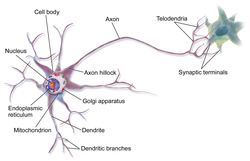 Anatomy of a multipolar neuron | |
| Identifiers | |
| MeSH | D009474 |
| NeuroLex ID | sao1417703748 |
| TA98 | A14.0.00.002 |
| Thursday | H2.00.06.1.00002 |
| FMA | 54527 |
| Anatomical terms of neuroanatomy [edit on Wikidata] | |
A neuron or nerve prison cell is an electrically excitable prison cell that communicates with other cells via specialized connections called synapses. The neuron is the main component of nervous tissue in all animals except sponges and placozoa. Plants and fungi exercise non have nerve cells.
Neurons are typically classified into three types based on their office. Sensory neurons reply to stimuli such as affect, sound, or light that affect the cells of the sensory organs, and they send signals to the spinal cord or brain. Motor neurons receive signals from the brain and spinal cord to control everything from musculus contractions to glandular output. Interneurons connect neurons to other neurons within the same region of the brain or spinal string. When multiple neurons are connected together they grade what is chosen a neural circuit.
A typical neuron consists of a cell torso (soma), dendrites, and a single axon. The soma is a meaty structure and the axon and dendrites are filaments extruding from the soma. Dendrites typically branch profusely and extend a few hundred micrometers from the soma. The axon leaves the soma at a swelling chosen the axon hillock and travels for as far as 1 meter in humans or more in other species. Information technology branches just unremarkably maintains a abiding diameter. At the farthest tip of the axon's branches are axon terminals, where the neuron can transmit a bespeak beyond the synapse to some other cell. Neurons may lack dendrites or have no axon. The term neurite is used to draw either a dendrite or an axon, particularly when the prison cell is undifferentiated.
About neurons receive signals via the dendrites and soma and send out signals down the axon. At the bulk of synapses, signals cantankerous from the axon of one neuron to a dendrite of some other. However, synapses can connect an axon to another axon or a dendrite to another dendrite.
The signaling process is partly electrical and partly chemical. Neurons are electrically excitable, due to maintenance of voltage gradients beyond their membranes. If the voltage changes past a large enough amount over a curt interval, the neuron generates an all-or-nothing electrochemical pulse chosen an activity potential. This potential travels quickly along the axon and activates synaptic connections as information technology reaches them. Synaptic signals may be excitatory or inhibitory, increasing or reducing the internet voltage that reaches the soma.
In near cases, neurons are generated past neural stem cells during brain development and childhood. Neurogenesis largely ceases during adulthood in nigh areas of the encephalon.
Nervous system [edit]
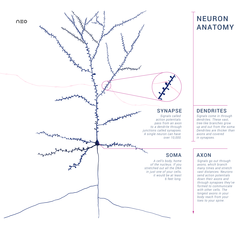
Schematic of an anatomically accurate unmarried pyramidal neuron, the primary excitatory neuron of cerebral cortex, with a synaptic connection from an incoming axon onto a dendritic spine.
Neurons are the primary components of the nervous system, along with the glial cells that give them structural and metabolic support. The nervous system is fabricated up of the fundamental nervous system, which includes the brain and spinal string, and the peripheral nervous organisation, which includes the autonomic and somatic nervous systems. In vertebrates, the majority of neurons vest to the central nervous system, but some reside in peripheral ganglia, and many sensory neurons are situated in sensory organs such every bit the retina and cochlea.
Axons may packet into fascicles that brand upwardly the nerves in the peripheral nervous organization (like strands of wire make up cables). Bundles of axons in the central nervous system are called tracts.
Anatomy and histology [edit]

Diagram of the components of a neuron
Neurons are highly specialized for the processing and transmission of cellular signals. Given their diversity of functions performed in different parts of the nervous system, there is a broad variety in their shape, size, and electrochemical properties. For instance, the soma of a neuron tin vary from 4 to 100 micrometers in diameter.[1]
- The soma is the body of the neuron. As it contains the nucleus, nearly protein synthesis occurs hither. The nucleus tin can range from 3 to 18 micrometers in diameter.[ii]
- The dendrites of a neuron are cellular extensions with many branches. This overall shape and structure is referred to metaphorically as a dendritic tree. This is where the majority of input to the neuron occurs via the dendritic spine.
- The axon is a finer, cablevision-similar projection that can extend tens, hundreds, or even tens of thousands of times the bore of the soma in length. The axon primarily carries nervus signals away from the soma, and carries some types of information back to it. Many neurons have but one axon, but this axon may—and ordinarily will—undergo extensive branching, enabling communication with many target cells. The function of the axon where information technology emerges from the soma is called the axon hillock. As well beingness an anatomical structure, the axon hillock likewise has the greatest density of voltage-dependent sodium channels. This makes information technology the nigh easily excited part of the neuron and the spike initiation zone for the axon. In electrophysiological terms, information technology has the nigh negative threshold potential.
- While the axon and axon hillock are generally involved in information outflow, this region can also receive input from other neurons.
- The axon terminal is constitute at the cease of the axon farthest from the soma and contains synapses. Synaptic boutons are specialized structures where neurotransmitter chemicals are released to communicate with target neurons. In improver to synaptic boutons at the axon concluding, a neuron may have en passant boutons, which are located along the length of the axon.
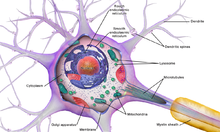
The accepted view of the neuron attributes defended functions to its diverse anatomical components; however, dendrites and axons often human activity in ways contrary to their so-chosen main office.[3]
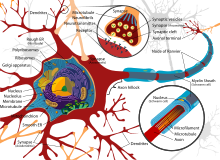
Diagram of a typical myelinated vertebrate motor neuron
Axons and dendrites in the central nervous organization are typically only nearly one micrometer thick, while some in the peripheral nervous system are much thicker. The soma is normally well-nigh 10–25 micrometers in diameter and often is not much larger than the cell nucleus it contains. The longest axon of a man motor neuron tin can be over a meter long, reaching from the base of the spine to the toes.
Sensory neurons tin can take axons that run from the toes to the posterior column of the spinal cord, over one.five meters in adults. Giraffes have single axons several meters in length running along the unabridged length of their necks. Much of what is known about axonal function comes from studying the squid behemothic axon, an ideal experimental preparation because of its relatively immense size (0.5–1 millimeters thick, several centimeters long).
Fully differentiated neurons are permanently postmitotic[4] however, stalk cells present in the adult encephalon may regenerate functional neurons throughout the life of an organism (see neurogenesis). Astrocytes are star-shaped glial cells. They have been observed to plough into neurons by virtue of their stem cell-like characteristic of pluripotency.
Membrane [edit]
Similar all brute cells, the cell body of every neuron is enclosed by a plasma membrane, a bilayer of lipid molecules with many types of poly peptide structures embedded in it. A lipid bilayer is a powerful electrical insulator, only in neurons, many of the protein structures embedded in the membrane are electrically agile. These include ion channels that permit electrically charged ions to menstruum beyond the membrane and ion pumps that chemically transport ions from ane side of the membrane to the other. Most ion channels are permeable only to specific types of ions. Some ion channels are voltage gated, significant that they can be switched betwixt open and closed states by altering the voltage difference across the membrane. Others are chemically gated, meaning that they tin can exist switched betwixt open and closed states by interactions with chemicals that lengthened through the extracellular fluid. The ion materials include sodium, potassium, chloride, and calcium. The interactions between ion channels and ion pumps produce a voltage difference across the membrane, typically a flake less than 1/10 of a volt at baseline. This voltage has 2 functions: commencement, it provides a power source for an assortment of voltage-dependent protein machinery that is embedded in the membrane; second, it provides a basis for electrical point transmission betwixt different parts of the membrane.
Histology and internal structure [edit]
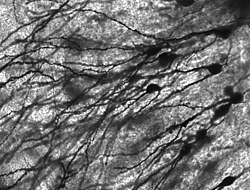
Golgi-stained neurons in human hippocampal tissue

Actin filaments in a mouse cortical neuron in culture
Numerous microscopic clumps chosen Nissl bodies (or Nissl substance) are seen when nerve cell bodies are stained with a basophilic ("base-loving") dye. These structures consist of rough endoplasmic reticulum and associated ribosomal RNA. Named after German psychiatrist and neuropathologist Franz Nissl (1860–1919), they are involved in poly peptide synthesis and their prominence can exist explained by the fact that nervus cells are very metabolically agile. Basophilic dyes such as aniline or (weakly) haematoxylin[5] highlight negatively charged components, and and then demark to the phosphate courage of the ribosomal RNA.
The cell body of a neuron is supported past a complex mesh of structural proteins called neurofilaments, which together with neurotubules (neuronal microtubules) are assembled into larger neurofibrils.[half-dozen] Some neurons as well contain paint granules, such as neuromelanin (a brownish-black paint that is byproduct of synthesis of catecholamines), and lipofuscin (a yellowish-dark-brown paint), both of which accumulate with age.[7] [8] [9] Other structural proteins that are of import for neuronal part are actin and the tubulin of microtubules. Class III β-tubulin is institute well-nigh exclusively in neurons. Actin is predominately establish at the tips of axons and dendrites during neuronal development. In that location the actin dynamics can exist modulated via an interplay with microtubule.[10]
There are different internal structural characteristics between axons and dendrites. Typical axons virtually never contain ribosomes, except some in the initial segment. Dendrites contain granular endoplasmic reticulum or ribosomes, in diminishing amounts as the distance from the cell trunk increases.
Classification [edit]
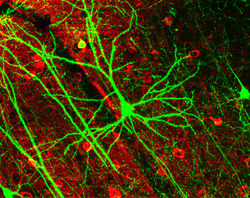
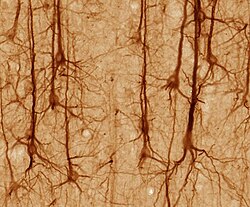
Neurons vary in shape and size and can be classified by their morphology and function.[12] The anatomist Camillo Golgi grouped neurons into two types; type I with long axons used to motility signals over long distances and type Ii with short axons, which can often exist confused with dendrites. Blazon I cells tin can be farther classified past the location of the soma. The basic morphology of type I neurons, represented by spinal motor neurons, consists of a cell torso chosen the soma and a long sparse axon covered by a myelin sheath. The dendritic tree wraps effectually the jail cell body and receives signals from other neurons. The end of the axon has branching axon terminals that release neurotransmitters into a gap called the synaptic scissure between the terminals and the dendrites of the adjacent neuron.
Structural classification [edit]
Polarity [edit]
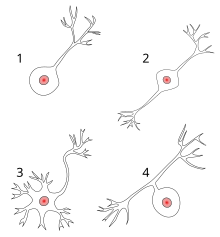
Nearly neurons can be anatomically characterized every bit:
- Unipolar: unmarried process
- Bipolar: ane axon and 1 dendrite
- Multipolar: 1 axon and ii or more than dendrites
- Golgi I: neurons with long-projecting axonal processes; examples are pyramidal cells, Purkinje cells, and anterior horn cells
- Golgi Two: neurons whose axonal process projects locally; the best example is the granule cell
- Anaxonic: where the axon cannot be distinguished from the dendrite(s)
- Pseudounipolar: 1 process which then serves equally both an axon and a dendrite
Other [edit]
Some unique neuronal types can be identified according to their location in the nervous system and distinct shape. Some examples are:
- Basket cells, interneurons that class a dense plexus of terminals around the soma of target cells, found in the cortex and cerebellum
- Betz cells, large motor neurons
- Lugaro cells, interneurons of the cerebellum
- Medium spiny neurons, most neurons in the corpus striatum
- Purkinje cells, huge neurons in the cerebellum, a type of Golgi I multipolar neuron
- Pyramidal cells, neurons with triangular soma, a blazon of Golgi I
- Renshaw cells, neurons with both ends linked to alpha motor neurons
- Unipolar castor cells, interneurons with unique dendrite ending in a brush-like tuft
- Granule cells, a type of Golgi II neuron
- Anterior horn cells, motoneurons located in the spinal cord
- Spindle cells, interneurons that connect widely separated areas of the brain
Functional classification [edit]
Direction [edit]
- Afferent neurons convey data from tissues and organs into the primal nervous organization and are also called sensory neurons.
- Efferent neurons (motor neurons) transmit signals from the central nervous arrangement to the effector cells.
- Interneurons connect neurons within specific regions of the fundamental nervous system.
Afferent and efferent also refer by and large to neurons that, respectively, bring information to or send information from the brain.
Action on other neurons [edit]
A neuron affects other neurons by releasing a neurotransmitter that binds to chemical receptors. The effect upon the postsynaptic neuron is determined by the blazon of receptor that is activated, not by the presynaptic neuron or by the neurotransmitter. A neurotransmitter can exist idea of as a key, and a receptor every bit a lock: the aforementioned neurotransmitter tin can activate multiple types of receptors. Receptors can be classified broadly equally excitatory (causing an increase in firing rate), inhibitory (causing a subtract in firing rate), or modulatory (causing long-lasting furnishings not directly related to firing rate).
The two most common (ninety%+) neurotransmitters in the encephalon, glutamate and GABA, take largely consistent actions. Glutamate acts on several types of receptors, and has effects that are excitatory at ionotropic receptors and a modulatory effect at metabotropic receptors. Similarly, GABA acts on several types of receptors, only all of them accept inhibitory furnishings (in adult animals, at least). Considering of this consistency, information technology is common for neuroscientists to refer to cells that release glutamate every bit "excitatory neurons", and cells that release GABA as "inhibitory neurons". Some other types of neurons have consistent furnishings, for example, "excitatory" motor neurons in the spinal string that release acetylcholine, and "inhibitory" spinal neurons that release glycine.
The stardom between excitatory and inhibitory neurotransmitters is not absolute. Rather, it depends on the course of chemical receptors nowadays on the postsynaptic neuron. In principle, a single neuron, releasing a single neurotransmitter, can have excitatory effects on some targets, inhibitory effects on others, and modulatory effects on others still. For example, photoreceptor cells in the retina constantly release the neurotransmitter glutamate in the absenteeism of lite. So-chosen OFF bipolar cells are, like most neurons, excited by the released glutamate. However, neighboring target neurons called ON bipolar cells are instead inhibited by glutamate, considering they lack typical ionotropic glutamate receptors and instead express a class of inhibitory metabotropic glutamate receptors.[xiii] When low-cal is present, the photoreceptors cease releasing glutamate, which relieves the ON bipolar cells from inhibition, activating them; this simultaneously removes the excitation from the OFF bipolar cells, silencing them.
It is possible to place the type of inhibitory upshot a presynaptic neuron volition have on a postsynaptic neuron, based on the proteins the presynaptic neuron expresses. Parvalbumin-expressing neurons typically dampen the output signal of the postsynaptic neuron in the visual cortex, whereas somatostatin-expressing neurons typically block dendritic inputs to the postsynaptic neuron.[14]
Discharge patterns [edit]
Neurons have intrinsic electroresponsive properties like intrinsic transmembrane voltage oscillatory patterns.[fifteen] So neurons can be classified according to their electrophysiological characteristics:
- Tonic or regular spiking. Some neurons are typically constantly (tonically) agile, typically firing at a constant frequency. Example: interneurons in neurostriatum.
- Phasic or bursting. Neurons that burn down in bursts are chosen phasic.
- Fast spiking. Some neurons are notable for their high firing rates, for example some types of cortical inhibitory interneurons, cells in globus pallidus, retinal ganglion cells.[xvi] [17]
Neurotransmitter [edit]
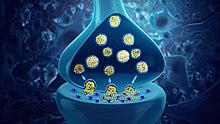
Synaptic vesicles containing neurotransmitters
Neurotransmitters are chemical messengers passed from i neuron to another neuron or to a muscle cell or gland prison cell.
- Cholinergic neurons – acetylcholine. Acetylcholine is released from presynaptic neurons into the synaptic cleft. It acts equally a ligand for both ligand-gated ion channels and metabotropic (GPCRs) muscarinic receptors. Nicotinic receptors are pentameric ligand-gated ion channels composed of alpha and beta subunits that bind nicotine. Ligand bounden opens the channel causing influx of Na+ depolarization and increases the probability of presynaptic neurotransmitter release. Acetylcholine is synthesized from choline and acetyl coenzyme A.
- Adrenergic neurons – noradrenaline. Noradrenaline (norepinephrine) is released from nigh postganglionic neurons in the sympathetic nervous arrangement onto ii sets of GPCRs: blastoff adrenoceptors and beta adrenoceptors. Noradrenaline is one of the 3 common catecholamine neurotransmitter, and the most prevalent of them in the peripheral nervous system; as with other catecholamines, it is synthesised from tyrosine.
- GABAergic neurons – gamma aminobutyric acrid. GABA is one of two neuroinhibitors in the central nervous arrangement (CNS), along with glycine. GABA has a homologous role to ACh, gating anion channels that permit Cl− ions to enter the post synaptic neuron. Cl− causes hyperpolarization within the neuron, decreasing the probability of an action potential firing as the voltage becomes more negative (for an action potential to fire, a positive voltage threshold must be reached). GABA is synthesized from glutamate neurotransmitters by the enzyme glutamate decarboxylase.
- Glutamatergic neurons – glutamate. Glutamate is one of ii primary excitatory amino acid neurotransmitters, along with aspartate. Glutamate receptors are i of iv categories, three of which are ligand-gated ion channels and one of which is a G-protein coupled receptor (often referred to as GPCR).
-
- AMPA and Kainate receptors function every bit cation channels permeable to Na+ cation channels mediating fast excitatory synaptic manual.
- NMDA receptors are some other cation channel that is more than permeable to Ca2+. The function of NMDA receptors depend on glycine receptor bounden as a co-agonist within the channel pore. NMDA receptors do not function without both ligands present.
- Metabotropic receptors, GPCRs attune synaptic transmission and postsynaptic excitability.
- Glutamate tin cause excitotoxicity when blood flow to the brain is interrupted, resulting in brain damage. When blood flow is suppressed, glutamate is released from presynaptic neurons, causing greater NMDA and AMPA receptor activation than normal exterior of stress weather, leading to elevated Caii+ and Na+ inbound the post synaptic neuron and cell damage. Glutamate is synthesized from the amino acid glutamine by the enzyme glutamate synthase.
- Dopaminergic neurons—dopamine. Dopamine is a neurotransmitter that acts on D1 blazon (D1 and D5) Gs-coupled receptors, which increase military camp and PKA, and D2 blazon (D2, D3, and D4) receptors, which activate Gi-coupled receptors that decrease cAMP and PKA. Dopamine is connected to mood and beliefs and modulates both pre- and postal service-synaptic neurotransmission. Loss of dopamine neurons in the substantia nigra has been linked to Parkinson'south disease. Dopamine is synthesized from the amino acid tyrosine. Tyrosine is catalyzed into levodopa (or L-DOPA) by tyrosine hydroxlase, and levodopa is and so converted into dopamine past the aromatic amino acid decarboxylase.
- Serotonergic neurons—serotonin. Serotonin (5-Hydroxytryptamine, 5-HT) can act as excitatory or inhibitory. Of its four v-HT receptor classes, iii are GPCR and 1 is a ligand-gated cation channel. Serotonin is synthesized from tryptophan past tryptophan hydroxylase, and then further by decarboxylase. A lack of five-HT at postsynaptic neurons has been linked to depression. Drugs that block the presynaptic serotonin transporter are used for treatment, such equally Prozac and Zoloft.
- Purinergic neurons—ATP. ATP is a neurotransmitter acting at both ligand-gated ion channels (P2X receptors) and GPCRs (P2Y) receptors. ATP is, however, best known as a cotransmitter. Such purinergic signalling can too be mediated past other purines similar adenosine, which particularly acts at P2Y receptors.
- Histaminergic neurons—histamine. Histamine is a monoamine neurotransmitter and neuromodulator. Histamine-producing neurons are institute in the tuberomammillary nucleus of the hypothalamus.[18] Histamine is involved in arousal and regulating sleep/wake behaviors.
Multimodel nomenclature [edit]
Since 2012 in that location has been a push button from the cellular and computational neuroscience community to come up up with a universal classification of neurons that will employ to all neurons in the brain as well as across species. This is washed past because the three essential qualities of all neurons: electrophysiology, morphology, and the individual transcriptome of the cells. Besides beingness universal this classification has the advantage of being able to allocate astrocytes too. A method called Patch-Seq in which all 3 qualities can be measured at once is used extensively by the Allen Institute for Encephalon Science.[nineteen]
Connectivity [edit]
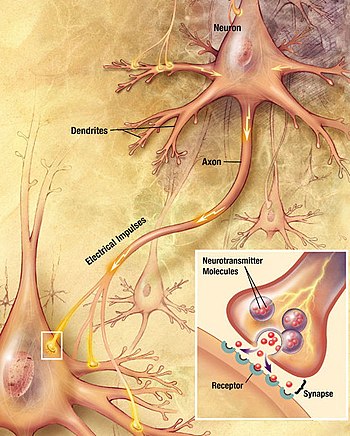
A signal propagating downwardly an axon to the jail cell trunk and dendrites of the next jail cell
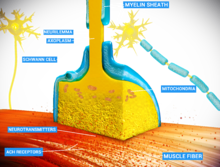
Neurons communicate with each other via synapses, where either the axon terminal of one prison cell contacts another neuron's dendrite, soma or, less normally, axon. Neurons such every bit Purkinje cells in the cerebellum can have over k dendritic branches, making connections with tens of thousands of other cells; other neurons, such every bit the magnocellular neurons of the supraoptic nucleus, have merely one or ii dendrites, each of which receives thousands of synapses.
Synapses tin be excitatory or inhibitory, either increasing or decreasing activity in the target neuron, respectively. Some neurons also communicate via electrical synapses, which are direct, electrically conductive junctions between cells.[20]
When an action potential reaches the axon terminal, it opens voltage-gated calcium channels, allowing calcium ions to enter the terminal. Calcium causes synaptic vesicles filled with neurotransmitter molecules to fuse with the membrane, releasing their contents into the synaptic cleft. The neurotransmitters diffuse across the synaptic scissure and activate receptors on the postsynaptic neuron. High cytosolic calcium in the axon concluding triggers mitochondrial calcium uptake, which, in turn, activates mitochondrial free energy metabolism to produce ATP to support continuous neurotransmission.[21]
An autapse is a synapse in which a neuron's axon connects to its own dendrites.
The human brain has some 8.6 x 10x (fourscore six billion) neurons.[22] Each neuron has on average 7,000 synaptic connections to other neurons. Information technology has been estimated that the brain of a 3-twelvemonth-erstwhile kid has about 1015 synapses (1 quadrillion). This number declines with age, stabilizing by machismo. Estimates vary for an adult, ranging from 1014 to 5 x 1014 synapses (100 to 500 trillion).[23]

An annotated diagram of the stages of an activity potential propagating down an axon including the office of ion concentration and pump and channel proteins.
Nonelectrochemical signaling [edit]
Beyond electrical and chemical signaling, studies suggest neurons in good for you human brains can also communicate through:
- force generated by the enlargement of dendritic spines[24]
- the transfer of proteins – transneuronally transported proteins (TNTPs)[25] [26]
They tin can also get modulated by input from the environment and hormones released from other parts of the organism,[27] which could be influenced more or less directly by neurons. This besides applies to neurotrophins such every bit BDNF. The gut microbiome is also continued with the brain.[28]
Mechanisms for propagating activity potentials [edit]
In 1937 John Zachary Immature suggested that the squid giant axon could be used to study neuronal electrical properties.[29] It is larger than but similar to human neurons, making it easier to study. Past inserting electrodes into the squid giant axons, authentic measurements were made of the membrane potential.
The cell membrane of the axon and soma contain voltage-gated ion channels that allow the neuron to generate and propagate an electric signal (an action potential). Some neurons also generate subthreshold membrane potential oscillations. These signals are generated and propagated by accuse-carrying ions including sodium (Na+), potassium (K+), chloride (Cl−), and calcium (Catwo+).
Several stimuli can activate a neuron leading to electrical activity, including pressure, stretch, chemic transmitters, and changes of the electric potential across the cell membrane.[30] Stimuli cause specific ion-channels within the jail cell membrane to open, leading to a flow of ions through the cell membrane, changing the membrane potential. Neurons must maintain the specific electrical properties that define their neuron type.[31]
Thin neurons and axons require less metabolic expense to produce and conduct activity potentials, but thicker axons convey impulses more rapidly. To minimize metabolic expense while maintaining rapid conduction, many neurons accept insulating sheaths of myelin around their axons. The sheaths are formed by glial cells: oligodendrocytes in the key nervous system and Schwann cells in the peripheral nervous arrangement. The sheath enables action potentials to travel faster than in unmyelinated axons of the aforementioned diameter, whilst using less free energy. The myelin sheath in peripheral nerves normally runs along the axon in sections about 1 mm long, punctuated by unsheathed nodes of Ranvier, which comprise a loftier density of voltage-gated ion channels. Multiple sclerosis is a neurological disorder that results from demyelination of axons in the key nervous system.
Some neurons do non generate action potentials, but instead generate a graded electrical signal, which in turn causes graded neurotransmitter release. Such not-spiking neurons tend to exist sensory neurons or interneurons, because they cannot carry signals long distances.
Neural coding [edit]
Neural coding is concerned with how sensory and other information is represented in the brain by neurons. The chief goal of studying neural coding is to characterize the relationship between the stimulus and the private or ensemble neuronal responses, and the relationships amidst the electrical activities of the neurons within the ensemble.[32] It is thought that neurons can encode both digital and analog data.[33]
All-or-none principle [edit]
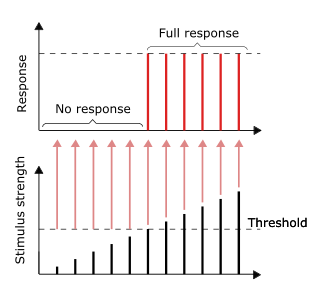
As long as the stimulus reaches the threshold, the full response would be given. Larger stimulus does not issue in a larger response, vice versa.[34] : 31
The conduction of nerve impulses is an example of an all-or-none response. In other words, if a neuron responds at all, then information technology must respond completely. Greater intensity of stimulation, like brighter image/louder sound, does not produce a stronger point, merely tin can increase firing frequency.[34] : 31 Receptors answer in unlike ways to stimuli. Slowly adapting or tonic receptors respond to steady stimulus and produce a steady rate of firing. Tonic receptors nigh ofttimes respond to increased intensity of stimulus by increasing their firing frequency, normally as a power function of stimulus plotted against impulses per second. This tin be likened to an intrinsic belongings of lite where greater intensity of a specific frequency (color) requires more photons, as the photons can't become "stronger" for a specific frequency.
Other receptor types include quickly adapting or phasic receptors, where firing decreases or stops with steady stimulus; examples include skin which, when touched causes neurons to fire, merely if the object maintains fifty-fifty pressure, the neurons stop firing. The neurons of the skin and muscles that are responsive to pressure and vibration take filtering accompaniment structures that aid their function.
The pacinian corpuscle is one such structure. It has concentric layers like an onion, which form around the axon terminal. When force per unit area is applied and the corpuscle is deformed, mechanical stimulus is transferred to the axon, which fires. If the pressure is steady, stimulus ends; thus, typically these neurons respond with a transient depolarization during the initial deformation and over again when the force per unit area is removed, which causes the corpuscle to alter shape again. Other types of adaptation are important in extending the office of a number of other neurons.[35]
Etymology and spelling [edit]
The German anatomist Heinrich Wilhelm Waldeyer introduced the term neuron in 1891,[36] based on the aboriginal Greek νεῦρον neuron 'sinew, cord, nerve'.[37]
The word was adopted in French with the spelling neurone. That spelling was also used by many writers in English,[38] but has now become rare in American usage and uncommon in British usage.[39] [37]
History [edit]
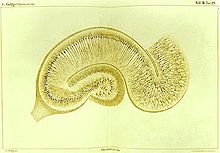
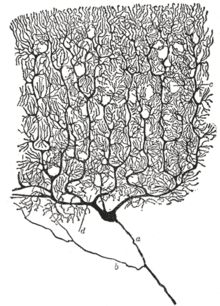
Drawing of a Purkinje jail cell in the cerebellar cortex done past Santiago Ramón y Cajal, demonstrating the ability of Golgi's staining method to reveal fine particular
The neuron's place every bit the primary functional unit of measurement of the nervous system was start recognized in the tardily 19th century through the piece of work of the Spanish anatomist Santiago Ramón y Cajal.[xl]
To make the construction of private neurons visible, Ramón y Cajal improved a silver staining process that had been developed by Camillo Golgi.[40] The improved process involves a technique called "double impregnation" and is still in use.
In 1888 Ramón y Cajal published a newspaper near the bird cerebellum. In this paper, he stated that he could not find evidence for anastomosis betwixt axons and dendrites and called each nervous element "an absolutely autonomous canton."[40] [36] This became known as the neuron doctrine, 1 of the central tenets of modern neuroscience.[40]
In 1891, the German language anatomist Heinrich Wilhelm Waldeyer wrote a highly influential review of the neuron doctrine in which he introduced the term neuron to describe the anatomical and physiological unit of measurement of the nervous arrangement.[41] [42]
The silver impregnation stains are a useful method for neuroanatomical investigations because, for reasons unknown, it stains merely a small pct of cells in a tissue, exposing the complete micro structure of individual neurons without much overlap from other cells.[43]
Neuron doctrine [edit]
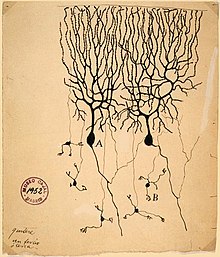
The neuron doctrine is the now fundamental idea that neurons are the basic structural and functional units of the nervous system. The theory was put forward by Santiago Ramón y Cajal in the tardily 19th century. It held that neurons are detached cells (not connected in a meshwork), interim as metabolically distinct units.
Later discoveries yielded refinements to the doctrine. For example, glial cells, which are non-neuronal, play an essential role in information processing.[44] Too, electric synapses are more common than previously thought,[45] comprising straight, cytoplasmic connections between neurons. In fact, neurons tin can form even tighter couplings: the squid giant axon arises from the fusion of multiple axons.[46]
Ramón y Cajal as well postulated the Law of Dynamic Polarization, which states that a neuron receives signals at its dendrites and cell body and transmits them, as action potentials, along the axon in ane direction: away from the cell body.[47] The Law of Dynamic Polarization has important exceptions; dendrites tin serve as synaptic output sites of neurons[48] and axons can receive synaptic inputs.[49]
Compartmental modelling of neurons [edit]
Although neurons are oftentimes described of as "fundamental units" of the brain, they perform internal computations. Neurons integrate input within dendrites, and this complexity is lost in models that assume neurons to be a primal unit. Dendritic branches can be modeled as spatial compartments, whose activity is related due to passive membrane backdrop, simply may also be different depending on input from synapses. Compartmental modelling of dendrites is especially helpful for agreement the behavior of neurons that are as well modest to tape with electrodes, as is the case for Drosophila melanogaster.[50]
Neurons in the brain [edit]
The number of neurons in the brain varies dramatically from species to species.[51] In a human, there are an estimated 10–20 billion neurons in the cerebral cortex and 55–70 billion neurons in the cerebellum.[52] By contrast, the nematode worm Caenorhabditis elegans has just 302 neurons, making it an ideal model organism as scientists accept been able to map all of its neurons. The fruit fly Drosophila melanogaster, a common subject in biological experiments, has around 100,000 neurons and exhibits many complex behaviors. Many properties of neurons, from the type of neurotransmitters used to ion channel limerick, are maintained across species, allowing scientists to study processes occurring in more circuitous organisms in much simpler experimental systems.
Neurological disorders [edit]
Charcot–Marie–Tooth disease (CMT) is a heterogeneous inherited disorder of nerves (neuropathy) that is characterized past loss of muscle tissue and affect sensation, predominantly in the feet and legs extending to the hands and arms in avant-garde stages. Presently incurable, this disease is one of the most mutual inherited neurological disorders, with 36 in 100,000 affected.[53]
Alzheimer's disease (AD), also known simply as Alzheimer'due south, is a neurodegenerative affliction characterized by progressive cognitive deterioration, together with failing activities of daily living and neuropsychiatric symptoms or behavioral changes.[54] The most striking early symptom is loss of short-term retentiveness (amnesia), which usually manifests as minor forgetfulness that becomes steadily more pronounced with illness progression, with relative preservation of older memories. As the disorder progresses, cognitive (intellectual) impairment extends to the domains of language (aphasia), skilled movements (apraxia), and recognition (agnosia), and functions such as determination-making and planning become impaired.[55] [56]
Parkinson's disease (PD), as well known as Parkinson illness, is a degenerative disorder of the central nervous system that often impairs motor skills and speech.[57] Parkinson'due south illness belongs to a group of conditions called movement disorders.[58] It is characterized by musculus rigidity, tremor, a slowing of concrete movement (bradykinesia), and in farthermost cases, a loss of physical movement (akinesia). The primary symptoms are the results of decreased stimulation of the motor cortex by the basal ganglia, normally caused past the insufficient formation and action of dopamine, which is produced in the dopaminergic neurons of the brain. Secondary symptoms may include high level cognitive dysfunction and subtle language issues. PD is both chronic and progressive.
Myasthenia gravis is a neuromuscular disease leading to fluctuating muscle weakness and fatigability during unproblematic activities. Weakness is typically caused past circulating antibodies that block acetylcholine receptors at the post-synaptic neuromuscular junction, inhibiting the stimulative effect of the neurotransmitter acetylcholine. Myasthenia is treated with immunosuppressants, cholinesterase inhibitors and, in selected cases, thymectomy.
Demyelination [edit]

Guillain–Barré syndrome – demyelination
Demyelination is the act of demyelinating, or the loss of the myelin sheath insulating the nerves. When myelin degrades, conduction of signals along the nerve can exist impaired or lost, and the nerve eventually withers. This leads to certain neurodegenerative disorders like multiple sclerosis and chronic inflammatory demyelinating polyneuropathy.
Axonal degeneration [edit]
Although most injury responses include a calcium influx signaling to promote resealing of severed parts, axonal injuries initially lead to astute axonal degeneration, which is the rapid separation of the proximal and distal ends, occurring within 30 minutes of injury. Degeneration follows with swelling of the axolemma, and eventually leads to bead-like formation. Granular disintegration of the axonal cytoskeleton and inner organelles occurs after axolemma degradation. Early on changes include accumulation of mitochondria in the paranodal regions at the site of injury. Endoplasmic reticulum degrades and mitochondria swell up and somewhen disintegrate. The disintegration is dependent on ubiquitin and calpain proteases (caused past the influx of calcium ion), suggesting that axonal degeneration is an active procedure that produces complete fragmentation. The process takes near roughly 24 hours in the PNS and longer in the CNS. The signaling pathways leading to axolemma degeneration are unknown.
Neurogenesis [edit]
Neurons are born through the process of neurogenesis, in which neural stem cells divide to produce differentiated neurons. One time fully differentiated neurons are formed, they are no longer capable of undergoing mitosis. Neurogenesis primarily occurs in the embryo of nearly organisms.
Adult neurogenesis can occur and studies of the age of homo neurons advise that this process occurs only for a minority of cells, and that the vast majority of neurons in the neocortex forms before birth and persists without replacement. The extent to which adult neurogenesis exists in humans, and its contribution to cognition are controversial, with conflicting reports published in 2018.[59]
The body contains a diversity of stem cell types that accept the capacity to differentiate into neurons. Researchers institute a way to transform man skin cells into nerve cells using transdifferentiation, in which "cells are forced to prefer new identities".[60]
During neurogenesis in the mammalian encephalon, progenitor and stem cells progress from proliferative divisions to differentiative divisions. This progression leads to the neurons and glia that populate cortical layers. Epigenetic modifications play a cardinal part in regulating cistron expression in differentiating neural stem cells, and are disquisitional for jail cell fate determination in the developing and adult mammalian brain. Epigenetic modifications include Dna cytosine methylation to course 5-methylcytosine and 5-methylcytosine demethylation.[61] These modifications are critical for prison cell fate decision in the developing and developed mammalian encephalon. DNA cytosine methylation is catalyzed by Dna methyltransferases (DNMTs). Methylcytosine demethylation is catalyzed in several stages past TET enzymes that carry out oxidative reactions (e.yard. 5-methylcytosine to 5-hydroxymethylcytosine) and enzymes of the Dna base excision repair (BER) pathway.[61]
At different stages of mammalian nervous system evolution two Deoxyribonucleic acid repair processes are employed in the repair of DNA double-strand breaks. These pathways are homologous recombinational repair used in proliferating neural precursor cells, and not-homologous end joining used mainly at later developmental stages[62]
Nerve regeneration [edit]
Peripheral axons can regrow if they are severed,[63] only one neuron cannot be functionally replaced by one of another type (Llinás' constabulary).[15]
See also [edit]
- Artificial neuron
- Bidirectional cell
- Biological neuron model
- Compartmental neuron models
- Connectome
- Dogiel cell
- Listing of animals past number of neurons
- Listing of neuroscience databases
- Neuronal galvanotropism
- Neuroplasticity
- Growth cone
- Sholl analysis
References [edit]
- ^ Davies, Melissa (2002-04-09). "The Neuron: size comparison". Neuroscience: A journey through the brain . Retrieved 2009-06-xx .
- ^ Chudler EH. "Brain Facts and Figures". Neuroscience for Kids . Retrieved 2009-06-20 .
- ^ "16.7: Nervous System". Biology LibreTexts. 2021-01-14. Retrieved 2022-02-28 .
- ^ Herrup One thousand, Yang Y (May 2007). "Prison cell cycle regulation in the postmitotic neuron: oxymoron or new biology?". Nature Reviews. Neuroscience. 8 (five): 368–78. doi:x.1038/nrn2124. PMID 17453017. S2CID 12908713.
- ^ Country Hospitals Bulletin. State Commission in Lunacy. 1897. p. 378.
- ^ "Medical Definition of Neurotubules". www.merriam-webster.com.
- ^ Zecca L, Gallorini M, Schünemann V, Trautwein AX, Gerlach K, Riederer P, Vezzoni P, Tampellini D (March 2001). "Iron, neuromelanin and ferritin content in the substantia nigra of normal subjects at different ages: consequences for fe storage and neurodegenerative processes". Periodical of Neurochemistry. 76 (6): 1766–73. doi:x.1046/j.1471-4159.2001.00186.x. PMID 11259494. S2CID 31301135.
- ^ Herrero MT, Hirsch EC, Kastner A, Luquin MR, Javoy-Agid F, Gonzalo LM, Obeso JA, Agid Y (1993). "Neuromelanin accumulation with age in catecholaminergic neurons from Macaca fascicularis brainstem". Developmental Neuroscience. 15 (1): 37–48. doi:x.1159/000111315. PMID 7505739.
- ^ Brunk UT, Terman A (September 2002). "Lipofuscin: mechanisms of historic period-related accumulation and influence on prison cell function". Gratis Radical Biology & Medicine. 33 (5): 611–9. doi:10.1016/s0891-5849(02)00959-0. PMID 12208347.
- ^ Zhao B, Meka DP, Scharrenberg R, König T, Schwanke B, Kobler O, Windhorst South, Kreutz MR, Mikhaylova 1000, Calderon de Anda F (August 2017). "Microtubules Modulate F-actin Dynamics during Neuronal Polarization". Scientific Reports. 7 (1): 9583. Bibcode:2017NatSR...7.9583Z. doi:10.1038/s41598-017-09832-viii. PMC5575062. PMID 28851982.
- ^ Lee WC, Huang H, Feng G, Sanes JR, Brown EN, So PT, Nedivi E (February 2006). "Dynamic remodeling of dendritic arbors in GABAergic interneurons of adult visual cortex". PLOS Biology. iv (2): e29. doi:10.1371/journal.pbio.0040029. PMC1318477. PMID 16366735.
- ^ Al, Martini, Frederic Et. Anatomy and Physiology' 2007 Ed.2007 Edition. Rex Bookstore, Inc. p. 288. ISBN978-971-23-4807-five.
- ^ Gerber U (January 2003). "Metabotropic glutamate receptors in vertebrate retina". Documenta Ophthalmologica. Advances in Ophthalmology. 106 (i): 83–7. doi:10.1023/A:1022477203420. PMID 12675489. S2CID 22296630.
- ^ Wilson NR, Runyan CA, Wang FL, Sur M (August 2012). "Segmentation and subtraction by distinct cortical inhibitory networks in vivo". Nature. 488 (7411): 343–viii. Bibcode:2012Natur.488..343W. doi:10.1038/nature11347. hdl:1721.ane/92709. PMC3653570. PMID 22878717.
- ^ a b Llinás RR (2014-01-01). "Intrinsic electrical backdrop of mammalian neurons and CNS function: a historical perspective". Frontiers in Cellular Neuroscience. 8: 320. doi:10.3389/fncel.2014.00320. PMC4219458. PMID 25408634.
- ^ Kolodin YO, Veselovskaia NN, Veselovsky NS, Fedulova SA. Ion conductances related to shaping the repetitive firing in rat retinal ganglion cells. Acta Physiologica Congress. Archived from the original on 2012-x-07. Retrieved 2009-06-20 .
- ^ "Ionic conductances underlying excitability in tonically firing retinal ganglion cells of adult rat". Ykolodin.50webs.com. 2008-04-27. Retrieved 2013-02-16 .
- ^ Scammell TE, Jackson Ac, Franks NP, Wisden W, Dauvilliers Y (January 2019). "Histamine: neural circuits and new medications". Sleep. 42 (1). doi:10.1093/sleep/zsy183. PMC6335869. PMID 30239935.
- ^ "Patch-seq technique helps draw the variation of neural cells in the brain". News-medical.cyberspace. 3 December 2020. Retrieved 26 August 2021.
{{cite web}}: CS1 maint: url-condition (link) - ^ Macpherson, Gordon (2002). Black'southward Medical Dictionary (40 ed.). Lanham, MD: Scarecrow Press. pp. 431–434. ISBN0810849844.
- ^ Ivannikov MV, Macleod GT (June 2013). "Mitochondrial free Ca²⁺ levels and their effects on energy metabolism in Drosophila motor nerve terminals". Biophysical Journal. 104 (11): 2353–61. Bibcode:2013BpJ...104.2353I. doi:ten.1016/j.bpj.2013.03.064. PMC3672877. PMID 23746507.
- ^ Herculano-Houzel S (November 2009). "The human brain in numbers: a linearly scaled-up primate brain". Frontiers in Homo Neuroscience. 3: 31. doi:x.3389/neuro.09.031.2009. PMC2776484. PMID 19915731.
- ^ Drachman DA (June 2005). "Do we take brain to spare?". Neurology. 64 (12): 2004–5. doi:10.1212/01.WNL.0000166914.38327.BB. PMID 15985565. S2CID 38482114.
- ^ Ucar, Hasan; Watanabe, Satoshi; Noguchi, Jun; Morimoto, Yuichi; Iino, Yusuke; Yagishita, Sho; Takahashi, Noriko; Kasai, Haruo (December 2021). "Mechanical deportment of dendritic-spine enlargement on presynaptic exocytosis". Nature. 600 (7890): 686–689. doi:10.1038/s41586-021-04125-vii. ISSN 1476-4687.
Lay summary:
"Forceful synapses reveal mechanical interactions in the brain". Nature. 24 Nov 2021. doi:10.1038/d41586-021-03516-0. Retrieved 21 February 2022. - ^ "Researchers discover new blazon of cellular communication in the encephalon". The Scripps Research Establish . Retrieved 12 February 2022.
- ^ Schiapparelli, Lucio M.; Sharma, Pranav; He, Hai-Yan; Li, Jianli; Shah, Sahil H.; McClatchy, Daniel B.; Ma, Yuanhui; Liu, Han-Hsuan; Goldberg, Jeffrey 50.; Yates, John R.; Cline, Hollis T. (25 January 2022). "Proteomic screen reveals diverse protein transport betwixt connected neurons in the visual organisation". Cell Reports. 38 (4). doi:10.1016/j.celrep.2021.110287. ISSN 2211-1247.
- ^ Levitan, Irwin B.; Kaczmarek, Leonard M. "Electrical Signaling in Neurons". Oxford University Press. doi:10.1093/med/9780199773893.001.0001/med-9780199773893-affiliate-iii.
- ^ O'Leary, Olivia F.; Ogbonnaya, Ebere Southward.; Felice, Daniela; Levone, Brunno R.; C. Conroy, Lorraine; Fitzgerald, Patrick; Bravo, Javier A.; Forsythe, Paul; Bienenstock, John; Dinan, Timothy G.; Cryan, John F. (one February 2018). "The vagus nerve modulates BDNF expression and neurogenesis in the hippocampus". European Neuropsychopharmacology. 28 (2): 307–316. doi:10.1016/j.euroneuro.2017.12.004. ISSN 0924-977X.
- ^ Chudler EH. "Milestones in Neuroscience Enquiry". Neuroscience for Kids . Retrieved 2009-06-20 .
- ^ Patlak J, Gibbons R (2000-eleven-01). "Electrical Activeness of Nerves". Action Potentials in Nerve Cells. Archived from the original on August 27, 2009. Retrieved 2009-06-20 .
- ^ Harris-Warrick, RM (October 2011). "Neuromodulation and flexibility in Central Blueprint Generator networks". Current Stance in Neurobiology. 21 (5): 685–92. doi:10.1016/j.conb.2011.05.011. PMC3171584. PMID 21646013.
- ^ Brown EN, Kass RE, Mitra PP (May 2004). "Multiple neural spike train data analysis: state-of-the-fine art and future challenges". Nature Neuroscience. 7 (five): 456–61. doi:ten.1038/nn1228. PMID 15114358. S2CID 562815.
- ^ Thorpe SJ (1990). "Spike arrival times: A highly efficient coding scheme for neural networks" (PDF). In Eckmiller R, Hartmann One thousand, Hauske G (eds.). Parallel processing in neural systems and computers. Due north-Kingdom of the netherlands. pp. 91–94. ISBN9780444883902. Archived from the original (PDF) on 2012-02-15.
- ^ a b Kalat, James W (2016). Biological psychology (12 ed.). Commonwealth of australia. ISBN9781305105409. OCLC 898154491.
- ^ Eckert R, Randall D (1983). Creature physiology: mechanisms and adaptations. San Francisco: W.H. Freeman. p. 239. ISBN978-0-7167-1423-i.
- ^ a b Finger, Stanley (1994). Origins of neuroscience : a history of explorations into brain function. Oxford University Press. p. 47. ISBN9780195146943. OCLC 27151391.
Ramon y Cajal's get-go paper on the Golgi stain was on the bird cerebellum, and it appeared in the Revista in 1888. He acknowledged that he found the nerve fibers to be very intricate, but stated that he could observe no evidence for either axons or dendrites undergoing anastomosis and forming nets. He called each nervous element 'an admittedly democratic canton.'
- ^ a b Oxford English Dictionary, third edition, 2003, s.v.
- ^ Mehta AR, Mehta PR, Anderson SP, MacKinnon BL, Compston A (Jan 2020). "Grey Affair Etymology and the neuron(east)". Brain. 143 (1): 374–379. doi:x.1093/brain/awz367. PMC6935745. PMID 31844876.
- ^ "Google Books Ngram Viewer". books.google.com . Retrieved xix December 2020.
- ^ a b c d López-Muñoz F, Boya J, Alamo C (October 2006). "Neuron theory, the cornerstone of neuroscience, on the centenary of the Nobel Prize laurels to Santiago Ramón y Cajal". Brain Inquiry Bulletin. 70 (4–six): 391–405. doi:ten.1016/j.brainresbull.2006.07.010. PMID 17027775. S2CID 11273256.
- ^ Finger, Stanley (1994). Origins of neuroscience : a history of explorations into brain office. Oxford University Printing. p. 47. ISBN9780195146943. OCLC 27151391.
... a man who would write a highly influential review of the bear witness in favor of the neuron doctrine ii years after. In his newspaper, Waldeyer (1891), ... , wrote that nerve cells terminate freely with end arborizations and that the 'neuron' is the anatomical and physiological unit of the nervous system. The word 'neuron' was born this way.
- ^ "Whonamedit - dictionary of medical eponyms". www.whonamedit.com.
Today, Wilhelm von Waldeyer-Hartz is remembered every bit the founder of the neurone theory, coining the term "neurone" to describe the cellular function unit of the nervous system and enunciating and clarifying that concept in 1891.
- ^ Grant K (October 2007). "How the 1906 Nobel Prize in Physiology or Medicine was shared between Golgi and Cajal". Encephalon Research Reviews. 55 (2): 490–eight. doi:10.1016/j.brainresrev.2006.11.004. PMID 17306375. S2CID 24331507.
- ^ Witcher MR, Kirov SA, Harris KM (January 2007). "Plasticity of perisynaptic astroglia during synaptogenesis in the mature rat hippocampus". Glia. 55 (i): 13–23. CiteSeerX10.1.1.598.7002. doi:10.1002/glia.20415. PMID 17001633. S2CID 10664003.
- ^ Connors BW, Long MA (2004). "Electrical synapses in the mammalian brain". Annual Review of Neuroscience. 27 (1): 393–418. doi:10.1146/annurev.neuro.26.041002.131128. PMID 15217338.
- ^ Guillery RW (June 2005). "Observations of synaptic structures: origins of the neuron doctrine and its current status". Philosophical Transactions of the Purple Society of London. Series B, Biological Sciences. 360 (1458): 1281–307. doi:10.1098/rstb.2003.1459. PMC1569502. PMID 16147523.
- ^ Sabbatini RM (Apr–July 2003). "Neurons and Synapses: The History of Its Discovery". Brain & Mind Magazine: 17.
- ^ Djurisic 1000, Antic S, Chen WR, Zecevic D (July 2004). "Voltage imaging from dendrites of mitral cells: EPSP attenuation and spike trigger zones". The Journal of Neuroscience. 24 (30): 6703–14. doi:10.1523/JNEUROSCI.0307-04.2004. hdl:1912/2958. PMC6729725. PMID 15282273.
- ^ Cochilla AJ, Alford S (March 1997). "Glutamate receptor-mediated synaptic excitation in axons of the lamprey". The Journal of Physiology. 499 (Pt two): 443–57. doi:10.1113/jphysiol.1997.sp021940. PMC1159318. PMID 9080373.
- ^ Gouwens NW, Wilson RI (2009). "Point propagation in Drosophila key neurons". Periodical of Neuroscience. 29 (19): 6239–6249. doi:x.1523/jneurosci.0764-09.2009. PMC2709801. PMID 19439602.
- ^ Williams RW, Herrup K (1988). "The control of neuron number". Annual Review of Neuroscience. 11 (1): 423–53. doi:x.1146/annurev.ne.11.030188.002231. PMID 3284447.
- ^ von Bartheld CS, Bahney J, Herculano-Houzel Southward (December 2016). "The search for true numbers of neurons and glial cells in the homo brain: A review of 150 years of cell counting". The Periodical of Comparative Neurology. 524 (18): 3865–3895. doi:ten.1002/cne.24040. PMC5063692. PMID 27187682.
- ^ Krajewski KM, Lewis RA, Fuerst DR, Turansky C, Hinderer SR, Garbern J, Kamholz J, Shy ME (July 2000). "Neurological dysfunction and axonal degeneration in Charcot-Marie-Tooth disease type 1A". Brain. 123 (7): 1516–27. doi:10.1093/brain/123.seven.1516. PMID 10869062.
- ^ "Almost Alzheimer's Disease: Symptoms". National Institute on Crumbling. Archived from the original on 15 January 2012. Retrieved 28 December 2011.
- ^ Burns A, Iliffe South (Feb 2009). "Alzheimer'due south illness". BMJ. 338: b158. doi:x.1136/bmj.b158. PMID 19196745. S2CID 8570146.
- ^ Querfurth HW, LaFerla FM (January 2010). "Alzheimer'due south disease". The New England Journal of Medicine. 362 (4): 329–44. doi:10.1056/NEJMra0909142. PMID 20107219. S2CID 205115756.
- ^ "Parkinson's Disease Information Folio". NINDS. 30 June 2016. Archived from the original on four January 2017. Retrieved 18 July 2016.
- ^ "Movement Disorders". The International Neuromodulation Society.
- ^ Kempermann Grand, Cuff FH, Aigner L, Song H, Curtis MA, Thuret S, Kuhn HG, Jessberger Due south, Frankland Pow, Cameron HA, Gould E, Hen R, Abrous DN, Toni North, Schinder AF, Zhao X, Lucassen PJ, Frisén J (July 2018). "Human Developed Neurogenesis: Evidence and Remaining Questions". Cell Stem Cell. 23 (1): 25–30. doi:10.1016/j.stem.2018.04.004. PMC6035081. PMID 29681514.
- ^ Callaway, Ewen (26 May 2011). "How to make a human neuron". Nature. doi:10.1038/news.2011.328.
By transforming cells from human skin into working nerve cells, researchers may have come up with a model for nervous-arrangement diseases and perhaps even regenerative therapies based on cell transplants. The achievement, reported online today in Nature, is the latest in a fast-moving field called transdifferentiation, in which cells are forced to prefer new identities. In the by year, researchers have converted connective tissue cells found in skin into heart cells, claret cells, and liver cells.
- ^ a b Wang Z, Tang B, He Y, Jin P (March 2016). "Dna methylation dynamics in neurogenesis". Epigenomics. eight (3): 401–14. doi:x.2217/epi.15.119. PMC4864063. PMID 26950681.
- ^ Orii KE, Lee Y, Kondo N, McKinnon PJ (June 2006). "Selective utilization of nonhomologous finish-joining and homologous recombination Deoxyribonucleic acid repair pathways during nervous system evolution". Proceedings of the National Academy of Sciences of the United states of america of America. 103 (26): 10017–22. Bibcode:2006PNAS..10310017O. doi:ten.1073/pnas.0602436103. PMC1502498. PMID 16777961.
- ^ Yiu Thousand, He Z (August 2006). "Glial inhibition of CNS axon regeneration". Nature Reviews. Neuroscience. seven (eight): 617–27. doi:10.1038/nrn1956. PMC2693386. PMID 16858390.
Further reading [edit]
- Bullock Th, Bennett MV, Johnston D, Josephson R, Marder E, Fields RD (Nov 2005). "Neuroscience. The neuron doctrine, redux". Science. 310 (5749): 791–3. doi:10.1126/science.1114394. PMID 16272104. S2CID 170670241.
- Kandel ER, Schwartz JH, Jessell TM (2000). Principles of Neural Science (4th ed.). New York: McGraw-Hill. ISBN0-8385-7701-6.
- Peters A, Palay SL, Webster HS (1991). The Fine Structure of the Nervous System (third ed.). New York: Oxford Academy Printing. ISBN0-nineteen-506571-ix.
- Ramón y Cajal Southward (1933). Histology (10th ed.). Baltimore: Wood.
- Roberts A, Bush BM (1981). Neurones without Impulses. Cambridge: Cambridge University Press. ISBN0-521-29935-7.
- Snell RS (2010). Clinical Neuroanatomy. Lippincott Williams & Wilkins. ISBN978-0-7817-9427-5.
External links [edit]
- Neurobiology at Curlie
- IBRO (International Encephalon Research Organization). Fostering neuroscience research especially in less well-funded countries.
- NeuronBank an online neuromics tool for cataloging neuronal types and synaptic connectivity.
- High Resolution Neuroanatomical Images of Primate and Non-Primate Brains.
- The Section of Neuroscience at Wikiversity, which presently offers two courses: Fundamentals of Neuroscience and Comparative Neuroscience.
- NIF Search – Neuron via the Neuroscience Information Framework
- Cell Centered Database – Neuron
- Complete list of neuron types co-ordinate to the Petilla convention, at NeuroLex.
- NeuroMorpho.Org an online database of digital reconstructions of neuronal morphology.
- Immunohistochemistry Epitome Gallery: Neuron
- Khan Academy: Anatomy of a neuron
- Neuron images
Source: https://en.wikipedia.org/wiki/Neuron
Posted by: fieldsforet1986.blogspot.com


0 Response to "How Long Is The Longest Neuron In The Human Body And Where Is It Located"
Post a Comment